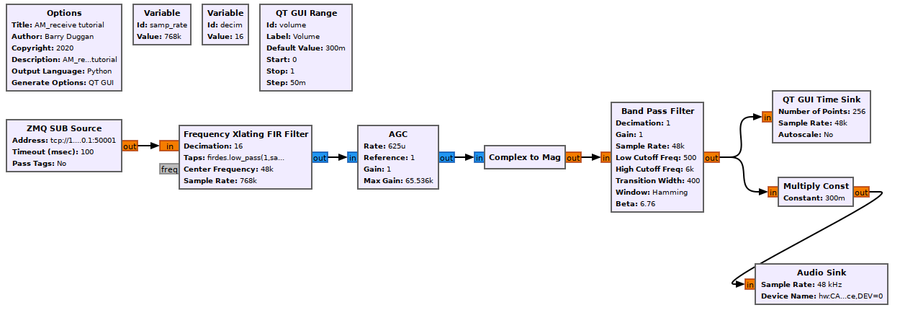ZMQ SUB Source: Difference between revisions
Jump to navigation
Jump to search
No edit summary |
|||
| (4 intermediate revisions by 2 users not shown) | |||
| Line 1: | Line 1: | ||
[[Category:Block Docs]] | [[Category:Block Docs]] | ||
Receive messages on ZMQ SUB socket and source stream. | |||
This block | This block will connect to a ZMQ PUB socket, then produce all incoming messages as streaming output. | ||
== Parameters == | == Parameters == | ||
(''R''): <span class="plainlinks">[https://wiki.gnuradio.org/index.php/GNURadioCompanion#Variable_Controls ''Run-time adjustable'']</span> | (''R''): <span class="plainlinks">[https://wiki.gnuradio.org/index.php/GNURadioCompanion#Variable_Controls ''Run-time adjustable'']</span> | ||
; Address | ; Address | ||
: ZMQ socket address specifier | : ZMQ socket address specifier. The format of the address is <code>tcp://*:port</code> where * should be 127.0.0.1 for localhost.<br> | ||
: <b>Note:</b> If the Source and Sink blocks are on two different computers on the same LAN, then the IP and port number of the Sink block must be specified on each end of that connection. For example, if the Sink is on IP 192.168.2.14:5678 and the Source is on IP 192.168.2.5, both Source and Sink blocks must specify the Sink IP and port (192.168.2.14:5678). | |||
; | ; Timeout | ||
: Receive timeout in milliseconds, default is 100ms | : Receive timeout in milliseconds, default is 100ms. | ||
; Pass Tags | |||
: Whether source will look for and deserialize tags. | |||
; Hign Watermark | |||
: High Watermark to configure the socket to (-1 => zmq's default) | |||
== Example Flowgraph == | == Example Flowgraph == | ||
This is a flowgraph of an Amplitude Modulation receiver. The signal from the transmitter section is received by the ZMQ SUB Source. It is a 48khz carrier with a sample rate of 768khz. For complete details, see [[Simulation_example:_AM_transmitter_and_receiver#AM_receiver]]. | |||
[[File:AM_receive_fg.png|900px]] | |||
== Source Files == | == Source Files == | ||
Revision as of 12:21, 14 April 2020
Receive messages on ZMQ SUB socket and source stream.
This block will connect to a ZMQ PUB socket, then produce all incoming messages as streaming output.
Parameters
(R): Run-time adjustable
- Address
- ZMQ socket address specifier. The format of the address is
tcp://*:portwhere * should be 127.0.0.1 for localhost. - Note: If the Source and Sink blocks are on two different computers on the same LAN, then the IP and port number of the Sink block must be specified on each end of that connection. For example, if the Sink is on IP 192.168.2.14:5678 and the Source is on IP 192.168.2.5, both Source and Sink blocks must specify the Sink IP and port (192.168.2.14:5678).
- Timeout
- Receive timeout in milliseconds, default is 100ms.
- Pass Tags
- Whether source will look for and deserialize tags.
- Hign Watermark
- High Watermark to configure the socket to (-1 => zmq's default)
Example Flowgraph
This is a flowgraph of an Amplitude Modulation receiver. The signal from the transmitter section is received by the ZMQ SUB Source. It is a 48khz carrier with a sample rate of 768khz. For complete details, see Simulation_example:_AM_transmitter_and_receiver#AM_receiver.
Source Files
- C++ files
- TODO
- Header files
- TODO
- Public header files
- TODO
- Block definition
- TODO
